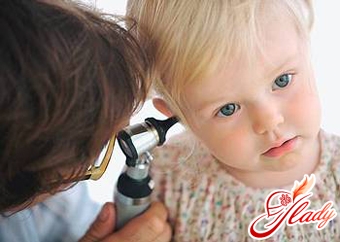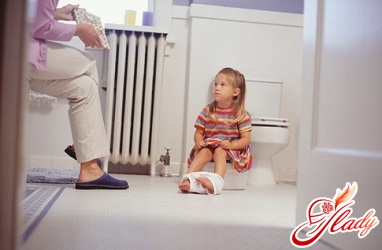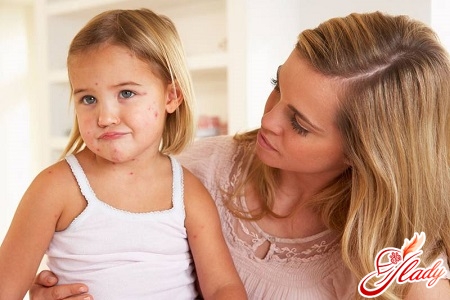
Skin is the first protective barrier of the body. It reflects the attacks of pathogenic factors, bacteria, viruses, participates in the regulation of temperature and water balance and performs many other important functions. Any changes in the skin are a cause for concern, to find out the causes and eliminate them. A rash on the body of a child is a local or general transfusion of the color, structure, and appearance of the skin that is not characteristic of a healthy organ. A rash in children is not always a manifestation of a pathology or a sign of a disease. It can be the usual response to the effect of an external stimulus, but often it indicates the appearance of disorders in the body. The causes of rashes in children are known for more than a hundred. Among them - diseases of internal organs, infectious, skin, parasitic, hereditary diseases of varying severity and danger, allergic processes. The features of changes on the skin are thoroughly studied and qualified by medical science and in many cases are characteristic of certain childhood diseases. Distinguish primary and secondary lesions with rashes. Elements of rashes are divided by morphology (color, size, consistency, appearance, topography). Rashes are monomorphic or polymorphous. Monomorphic rash - consists of the same primary elements, for example, spots, blisters, roseol, and polymorphous - from several. Eruptions can affect the epithelial layer of the skin, but are also deeper, affecting the layer of the dermis and underlying tissues with the formation of ulcers and erosions. Understand this is not easy, but as a rule, as the young children grow up, their mothers become authoritative specialists, because one of the pillars of knowledge is practice.
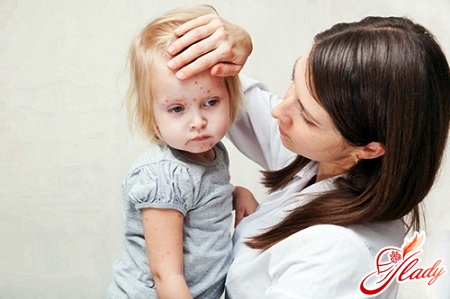
Physiological skin rashes in infants
The skin of infants is particularly prone torashes. During the first months after birth, the formation of the skin continues, which can be accompanied by the appearance of various eruptions on the body of infants, which physicians consider quite physiological. Such conditions include the "vascular phenomenon of newborns" - the marble of the dermis. Each tenth child up to six months of age with a slight decrease in air temperature, there are pale spots that occur when warming. This is due to the delay in the expansion of capillaries and small vessels due to the age-related hypothalamus hypothalamus and does not require special measures. Almost half of the children have toxic erythema in the first three days after birth. On the body of the baby, except for the feet and palms, there is a vesicle-pustular rash - swollen red spots and vesicles that gradually become like mosquito bites. This manifestation of infection with herpes, candida or staphylococcus, often taken for an allergic reaction, usually takes a week, without requiring treatment. Nearly every second newborn on the face, and sometimes on the body, genitals and mucous membranes appear sebaceous cysts in the form of white or yellow vesicles about 2 mm in diameter. And every fifth - on the forehead and cheeks there are acne - comedones, vesicles or pimples. They pass without a trace approximately to the 3rd month, when the excretory functions of the sebaceous glands are established. In the first month, 40% of newborns do not fully work sweat glands and ducts. Accumulations of sweat on the skin: on the chest, neck, in the skin folds, - form vesicles. These are small bubbles with a clear liquid or pimples of white or red color. If the sweat ducts are clogged in the deep layers of the dermis, allergic phenomena, climatic hyperhidrosis, or red sweating develop - bubbles appear with a liquid of red color. They quickly dry up and peel off, causing severe itching. Features of the skin of infants require strict adherence to hygiene rules and temperature conditions. But even the most caring mothers know what is diaper rash, sweating and diaper dermatitis in infants. They appear even with perfect care, especially in hot weather, and, without presenting a danger to the child, give him anxiety, making him irritable and whiny. 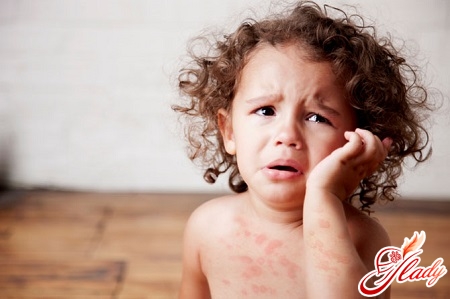
Anxiety pigmentation: infectious childhood diseases
Rashes on the skin of the child are accompanied by severalinfectious diseases. Features of the rash: appearance, localization, nature and timing of the spread from the onset of the disease - in many ways help to determine the diagnosis. Rubella, measles, chicken pox, scarlet fever at the first manifestations may have similar symptoms. The insidiousness of childhood infectious diseases, accompanied by specific changes in the skin, is that they start with the usual acute viral infections and sore throats. With an unfavorable outcome, they often provoke severe complications: nephritis, encephalitis, pneumonia. It is important to identify signs of anxiety in a timely manner and call a doctor. With normal measles, rubella and chickenpox there is no need for hospitalization or specific treatment. It is enough to provide the child with bed rest and follow the doctor's recommendations, isolate it for the duration of the virus activity. Babies before the age of one year can be vaccinated against rubella and measles. This does not eliminate the danger of the disease completely, but gives a guarantee for its more calm flow and removes the threat of complications. In immunocompromised children, immunity persists for life. And in our time, children often get measles ... Measles is one of the most common acute childhood diseases, according to WHO, almost 95% of the world's people have had measles. The peak of measles diseases is the end of winter, and most often outbreaks occur in kindergartens and junior schools. The incubation period - the time from the moment the virus enters the body before the appearance of severe symptoms of the disease - lasts from one to two weeks. The onset of the disease occurs abruptly: the temperature rises, a runny nose, barking cough, conjunctivitis and photophobia develop. A characteristic feature of measles is whitish rashes in the oral cavity, appearing a second or third day after the temperature rises. After them, 1-2 days later, a small pinkish rash spreads through the body: first behind the ears and on the forehead, then on the face, neck, gradually embracing the whole body and limbs and increasing in size. Such a consistent development of the rash is very characteristic. The rash in the form of spots and papules with a severe form of the disease becomes similar to hemorrhagic - almost circular formations slightly rise above the surface of the skin. When they appear, they have a diameter of 3-5 mm, then can grow to 15 mm and merge into extensive solid areas - erythematous spots, especially on the face and upper body. After two or three days, the peak of the maximum precipitation occurs, which is accompanied by a rise in temperature to 40.5 ° C. After 4-7 days the rash gradually disappears, leaving the flaky areas of brownish pigmentation, which pass through 7-10 days. Measles often gives complications that can occur in severe conditions: otitis media, bronchopneumonia, inflammation of the cervical lymph nodes, laryngitis and encephalitis. The contagious period (when the patient is contagious to others) with measles begins on the first day of fever and ends on the 4th-5th day of skin rashes (11 to 16 days after infection). Special treatment for measles does not require, usually limited to symptomatic therapy, a diet with a predominance of liquid food and compliance with bed rest. ... and also rubella and chickenpox. Very common infectious disease - measles rubella. Rubella mainly affects children aged 3 to 15 years. It is less contagious than measles, but it poses a great threat to pregnant women: it can lead to miscarriages or, with a 50% chance, to the birth of children with severe vices (blindness, deafness, heart and brain anomalies). The disease begins with a slight increase in temperature, a cold, headache, sometimes with conjunctivitis, but less pronounced than with measles. On the back of the neck, behind the ears, on the back of the neck lymph nodes increase, and on the soft sky red spots develop. Numerous small spots of the rash (3-7 mm in diameter) are noticeable on the first day of the disease - on the face, neck and internal folds of the limbs, appear throughout the body for several hours. The skin around the spots can be red, and the rash is often mistaken for scarlet fever. The rashes last about three days, at which time the fever keeps. In some cases, the rash is almost invisible, and sometimes - the only symptom of rubella. Unlike measles, with rubella, rashes are localized on the folds of the limbs, back, waist, buttocks and are less pronounced on the face, and the stage of their appearance is not traced. Chickenpox, or chicken pox, begins with an increase in temperature to 39 ° C, for 2-3 days there is a characteristic rash - small vesicle vesicles up to 5 mm in size. At first they are few and they arise on the head and face, then on the trunk and gradually cover the arms and legs, leaving the feet and palms intact. The appearance of new bubbles is accompanied by an increase in temperature. Eruptions with chickenpox undergo a clear change: red spots turn into nodules measuring 1-5 mm, in a few hours they fill with liquid, turning into vesicles surrounded by reddened skin. Vesicles burst, dry up to brownish crusts, which gradually depart. This cycle is accompanied by itching, especially strong at the stage of vesicles and fresh crusts. If these crusts are removed forcibly - the scars remain on the skin - pockmarks.  Additional danger of erythema infectiousmostly children are ill, more often in winter and in spring. When infected with a background of malaise, chills, a child's headache, myalgia is concerned. The next phase of the disease comes after 3 weeks of rashes on the cheekbones, which look like red relief points that merge into bright symmetrical papular spots reminiscent of slap marks. Over the next two days, the whole surface of the body quickly becomes covered with swollen red spots with a pale middle. The rash usually looks like a lace, sometimes it looks like a measles or hemorrhagic and can be accompanied by itching. After a week, the skin clears, but for some time, especially in the sun or after water procedures, relapses are possible. In children with good immunity, the infection passes without treatment. Sudden exanthema (roseola) is also a viral infection, it affects children of infant and young age. The disease begins with a sudden jump in temperature to 39 ° C and above, and the baby's skin becomes covered with pinkish convex rashes of the type of allergic, especially abundant on the neck and trunk. They last less than a day. Concomitant symptoms of exanthema can be a liquid mucous stool, swelling of cervical and ear lymph nodes, less often an enlargement of the liver or spleen.
Additional danger of erythema infectiousmostly children are ill, more often in winter and in spring. When infected with a background of malaise, chills, a child's headache, myalgia is concerned. The next phase of the disease comes after 3 weeks of rashes on the cheekbones, which look like red relief points that merge into bright symmetrical papular spots reminiscent of slap marks. Over the next two days, the whole surface of the body quickly becomes covered with swollen red spots with a pale middle. The rash usually looks like a lace, sometimes it looks like a measles or hemorrhagic and can be accompanied by itching. After a week, the skin clears, but for some time, especially in the sun or after water procedures, relapses are possible. In children with good immunity, the infection passes without treatment. Sudden exanthema (roseola) is also a viral infection, it affects children of infant and young age. The disease begins with a sudden jump in temperature to 39 ° C and above, and the baby's skin becomes covered with pinkish convex rashes of the type of allergic, especially abundant on the neck and trunk. They last less than a day. Concomitant symptoms of exanthema can be a liquid mucous stool, swelling of cervical and ear lymph nodes, less often an enlargement of the liver or spleen.
Allergy and its consequences
Often in children, allergic skinrashes, which is due to the immaturity of their immune system. Allergic reactions are the response of the immune system to an external stimulus. They can be food products, household chemicals, toys, plants, insect bites, medications and much more. Allergic reactions can occur even after a brief contact with the irritant, for example, nettle or jellyfish. Allergic phenomena start suddenly, often accompanied by a strong cold, lacrimation and itching. In some parts of the skin or on the entire body, irritations, red spots, prominent large blisters appear. A rash in a child can be accompanied by edema of the face, joints. In especially severe cases of an allergic reaction, with edema of the gastrointestinal mucosa, nausea and vomiting are possible, and swelling of the nasopharynx and tongue can cause suffocation and even an allergic shock. To the diseases of allergic nature is urticaria, its cause is the increased sensitivity of the body tissues to certain elective substances. The action of the allergen increases the permeability of the walls of the skin capillaries, and excess fluid enters the dermis, causing multiple edema of the papillary layer of the dermis, which leads to the formation of blisters framed by the reddened skin. Urticaria can cause some food products (strawberries, citrus fruits, mollusks), medicines, inhaled substances (pollen of plants or household dust), skin contact with some materials, plants, sun rays or cold, as well as bites of insects, parasites and even emotional stress. Chronic allergic reactions can lead to unpleasant skin diseases - toxicoderms. Disease in mild form is accompanied by rashes on the body like a urticaria. In severe forms, pustules, vascular or hemorrhagic spots form on the skin, possibly the development of erythema - thinning of the areas of the surface layers of the skin. Of course, there are many other reasons that cause changes in baby skin: from relatively innocuous, such as mosquito bites, to dangerous ones - scarlet fever, meningitis, psoriasis. It is not always possible to protect children from disease, but efforts to strengthen the immunity of the child will reduce the risk of infection several times.







